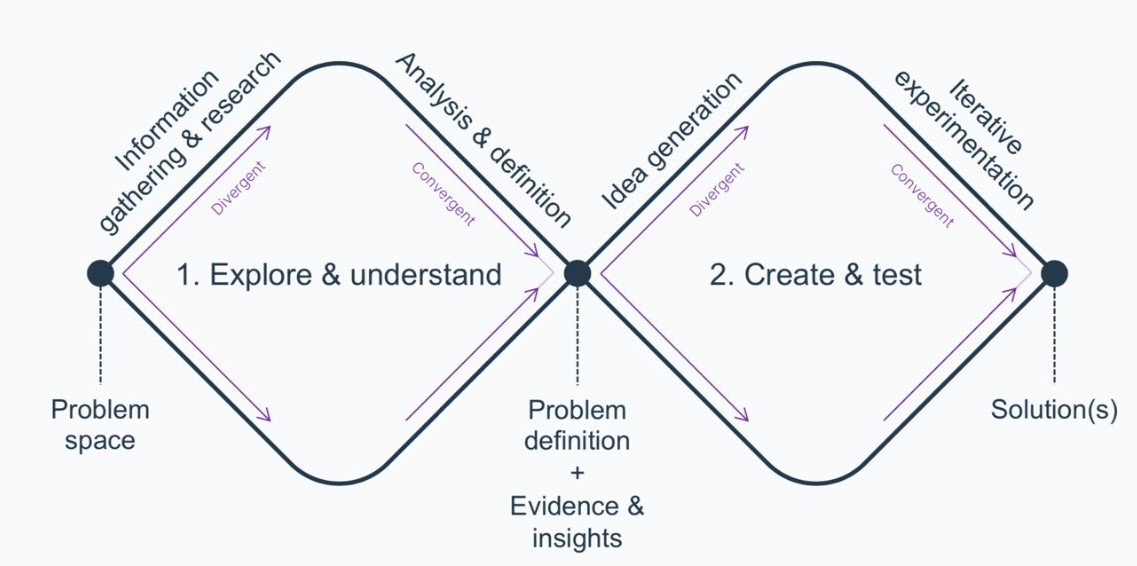
‘CoLab’ is the abbreviated name we gave our Policy and Innovation Lab. That’s because it brings together colleagues from policy, technology and operations to collaborate on solving shared problems.
It is people-focused – we use user research to uncover the needs of citizens and staff. These are combined with what we know about how the Home Office operates and what actionable solutions our policies intend to deliver. This collaborative approach helps reduce the likelihood of unintended consequences emerging later.
At its core, CoLab provides a structured and repeatable approach to solving problems. The approach is flexible and can be applied to a range of different problems and deliver diverse solutions.
This is not a new approach – it builds on the work of many others – but it’s new to the Home Office and we’d like to show how user-centred design can add value and support business objectives.
Understanding the problem
We’ve drawn on the Design Council’s ‘Double Diamond’, a known framework for design thinking and methods. Diagram A shows how we have adapted the ‘Double Diamond’ for our purposes.

Diagram A: CoLab’s adapted diagram of the Design Council’s ‘Double Diamond’ approach to design thinking and methods.
This framework is helpful because it illustrates that first we should understand a problem – from all sides – before we attempt to solve it. In CoLab we call this stage ‘Explore and understand’. To do this well, qualitative user research must be carried out with the people who are involved at all stages of the process.
It is this deep understanding that helps us arrive at a problem definition and allows us to accurately define target outcomes - the change we hope to see by solving a problem.
Clearly defining a target outcome before we act is critical as it allows us to:
- experiment with different actions to gather evidence for what works best
- measure the result after implementation to understand how successful we’ve been
A high-quality product or service should balance user, policy and service provider needs, so target outcomes can come from any of these perspectives. They are not mutually exclusive, and it is common for goals to overlap.
Generating and assessing ideas
Next we move into ‘Create and test’ which is about finding potential solutions. We do this by generating multiple ideas based on the evidence and insights from research. This is called ideation. We then use a structured method to reduce these to a more manageable number to work with in the lab.
We assess ideas, one by one, as a group (preferably the same group involved in ideation). We use a scorecard with a number of criteria to give some rigour to the process. These criteria will depend on the particular problem but should always include the anticipated:
- feasibility
- viability
- desirability
- contribution to each target outcome
Also, if applicable, criteria should also include the anticipated impact on:
- the public
- staff operations
- each individual service stage in scope
Diagram B illustrates how our criteria helps us decide which idea to pursue.

Diagram B: A Venn diagram showing the criteria for deciding whether an idea is worthwhile.
Creating hypotheses
Next, we create hypotheses from our top ideas. A hypothesis states that an idea will contribute to achieving a specified target outcome, and includes:
- why we expect this outcome
- how we will measure success
Hypothesis example
Table A demonstrates how we arrive at a hypothesis.
| If (the idea): | decision-making logic is simplified and codified into a set of business rules |
| then (the outcome): | the average decision-making time will be reduced |
| because (why it might work): | research shows avoidable checks and consideration by decision makers - driven by grey areas in policy guidance - are the most time-consuming element of the current process. |
| Success will be measured by: | a reduction in average decision-making times. |
Table A: An example of the format for creating a hypothesis.
Testing good ideas
Experimentation is the backbone of CoLab. We use design experiments to test our hypotheses to see whether the result is what we hoped or expected.
Inevitably, much lab activity also focuses on simply finding things out, such as what governance structures an idea will need to navigate to succeed or how much something costs.
Although we use technologists to enable experiments, we’re equally focused on exploring non-technical solutions, through all sorts of ‘materials’ that organisations work with. This includes people, policy, process, communication and infrastructure.
Experimentation during the ‘Create and test’ stage gives us confidence that a chosen idea will be effective. As far as possible, we include members of the proposed implementation team during this stage. This supports a thorough handover of recommended designs to be taken forward into implementation.
In our next post we’ll share our first case study, showing how we applied the CoLab method to a real-life Home Office problem.
We are currently recruiting for a Senior Developer – Creative Technologist at CoLab, DDaT Home Office. Applications close 23 August 2020.
We are also recruiting for a Head of Policy & Innovation Lab at CoLab, DDaT Home Office. Applications close 30 August 2020.

1 comment
Comment by john mortimer posted on
This is a welcome move, that is certainly a step up from traditional problem solving. It brings collaboration, which can be a start for transformation.
If you also begin to introduce systems thinking into this approach, then you will be able to both deepen the realisations that you will come up with, but also see issues in a way that moves away from current constraints that we often do not realise we have.
It will also assist with how to deal with conflicting 'stakeholders' and the deeper aspects of customer interactions into what truly matters to citizens,